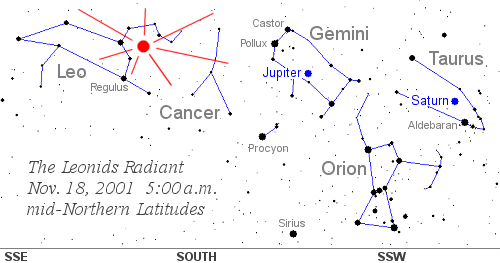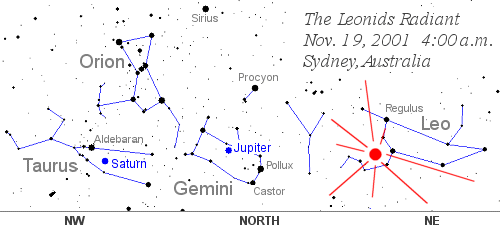|
A team of NASA-led scientists will monitor Leonid meteor activity around the world on Nov. 18, 2001. back to spaceweather.com In 1899, European and American astronomers confidently forecast a Leonid meteor storm. It would erupt, they said, on Nov. 18th when Earth passed close to the orbit of comet Tempel-Tuttle -- th eparent of the Leonid shower. Similar storms had dazzled sky watchers in 1833 and 1866, so millions of people -- even folks normally indifferent to the heavens -- were outdoors at the appointed time. Anticipation was high. But nothing happened; the storm was a dud. "[It was] the worst blow ever suffered by astronomy in the eyes of the public," wrote 19th century astronomer Charles Olivier. Astronomers of his day simply couldn't predict the Leonids. Fast forward 100 years. In 1999, sky watchers were once again hoping for an outburst of Leonids. Astronomers David Asher and Rob McNaught, using computer models of debris streams from Tempel-Tuttle, had predicted a Leonid meteor storm over Europe and the Middle East. Millions of people again ventured outdoors. And they were rewarded as several thousand meteors per hour streaked across the sky. Asher and McNaught had not only predicted where the storm would happen, but also when -- within 5 minutes! Leonid meteor forecasting has clearly improved since the 19th century. But it's not perfect yet, say researchers. Indeed, four leading teams of meteor forecasters who agree that another Leonid storm will erupt this weekend differ on the details. Says Bill Cooke, of the NASA Marshall Space Flight Center: "According to our model, sky watchers in Hawaii will see the greatest number of meteors -- one thousand or so per hour -- when Earth passes through a dusty debris stream shed by Tempel-Tuttle in 1799." Other researchers expect bigger flurries over North America and east Asia. Estimated rates range from 800 meteors per hour to more than 8000!  Predictions differ because: To find out who's right, a team of astronomers led by Rob Suggs, also at NASA Marshall, and Bill Cooke, will spread out around the world on November 17, 18 and 19 to count meteors as Earth passes through the various debris streams from comet Tempel-Tuttle. The NASA observers, along with colleagues from the University of Western Ontario and the U.S. Air Force, will monitor the storm from six locations: Huntsville, Ala.; Eglin Air Force Base, Fla.; Maui, Hawaii; Sunspot, N.M.; the U.S. Territory of Guam, and the Gobi Dessert in Mongolia. "We selected these sites based on both weather and meteor forecasts," explains Rob Suggs. "They all have a good chance of clear skies on Nov. 18th, and they are good places to see the peaks predicted by the various research groups." Each of the worldwide teams, consisting of a half-dozen observers each, will monitor the skies using a battery of image intensified video cameras that can detect stars as faint as 8th magnitude. (For comparison, the unaided human eye can see stars of 6th magnitude against a very dark sky. An 8th magnitude star is 6.3 times dimmer than a 6th magnitude star.) "Hopefully, we'll see them the old-fashioned way, too -- with our own eyes!" adds Cooke. After the storm is over, Cooke and his colleagues will use the data to evaluate this year's Leonid forecasts. "Our goal is to figure out what works and what doesn't," explains Cooke.
Every hour, the teams will relay their observations to the
Leonid Environment Operations Center at the Marshall Space Flight
Center, helping to paint a comprehensive picture of the meteor
storm.
Leonid meteors will appear to stream from a point (called the radiant) in Leo the Lion. The constellation is easy to spot: it has a characteristic question-mark shape punctuated by the bright star Regulus. Look for it rising above your eastern horizon between local midnight and 1:00 a.m.  Above: The southern sky as viewed from mid-northern latitudes on the date of the 2001 Leonid meteor shower. The Leonid radiant is denoted by a red dot. The Leonid radiant will climb higher as the night unfolds, reaching a maximum altitude of about 65 degrees at mid-northern latitudes, but only 30 degrees in, say, southern Australia. Because the radiant lies higher in northern skies, the northern hemisphere is generally a better place to spot Leonids. However, this year an predicted outburst over Australia could compensate for the low-hanging radiant and produce a dazzling show there. Staring directly toward the radiant is not necessarily the best way to enjoy the shower. Leonids that appear there will seem short and stubby -- a result of foreshortening. Instead, look toward any dark region of the sky 45 to 60 degrees away. You'll see just as many Leonids, but they will seem longer and more dramatic. The tails of all Leonid meteors, no matter where they appear, will point back toward the radiant in Leo.  Above: The northern sky as viewed from Sydney, Australia, on the date of the 2001 Leonid meteor shower. The Leonid radiant is denoted by a red dot. And finally, Earthgrazers: if you begin observing before Leo rises -- that is, around local midnight -- and a Leonid meteor outburst occurs, then you may spot a flurry of shooting stars called Earthgrazers. These are disintegrating meteoroids that fly over the horizon nearly parallel to the atmosphere. They produce long colorful tails. Usually Earthgrazers are remarkably slow-moving, but Leonid meteoroids are the fastest known. They strike Earth's atmosphere traveling 72 km/s (161,000 mph!) and so appear to streak very quickly across the sky. Even the Earthgrazing variety of Leonid meteors may appear fast-moving. Clear skies and good meteor hunting! |